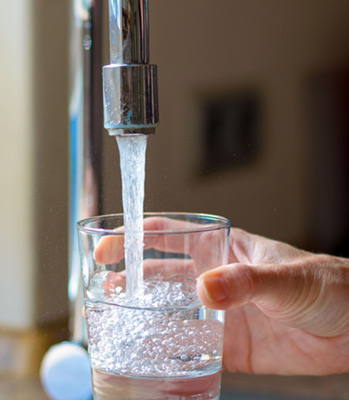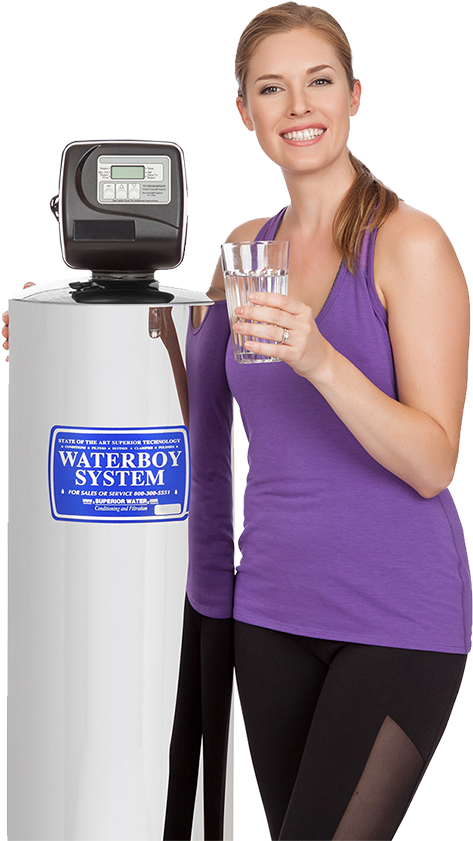Water 101
Contact Us to Learn More Today

What to Know About Household Water
Water Quality Problems: Health and Household
“When you fill a glass with water from your tap, you expect to drink water that is pure and safe. But how safe is it?
Water contains impurities from natural and man-made sources, such as minerals, gases, bacteria, metals and chemicals. Many of these impurities are harmless. However, some impurities can adversely affect your health. Others can damage equipment, stain laundry and fixtures and emit odors.
To protect the public health and ensure uniform standards for water quality nationwide, Congress passed the Safe Drinking Water Act of 1974. This act and its amendments authorized the U.S. Environmental Protection Agency (EPA) to establish limits on the concentration of certain contaminants in public water supplies (systems serving more than 25 people or 15 year-round connections). Private water supplies, including wells, are not regulated by drinking water standards. The owner must test and treat the water as needed to avoid health risks.”
DD
Dale Dorman, MS
Extension Housing & Environment Specialist
Department of Housing and Consumer Economics
Drinking Water Standards
The EPA standards for drinking water fall into two categories – Primary Standards and Secondary

Primary Drinking Water
Regulate contaminants that affect the safety of drinking water and may cause health problems. These standards are enforced by EPA. They protect you from three classes of toxic pollutants: microbial pathogens, radioactive elements and organic/inorganic chemicals. Many of these contaminants occur naturally in trace amounts in ground or surface water. Primary Standards set a limit, called the Maximum Contaminant Level (MCL) on the highest amount of a specific contaminant allowed in the drinking water supplied by a public water system. The MCL is usually expressed in milligrams per liter (mg/L). See Chart I for Primary Drinking water standards including organic/inorganic chemicals, radioactive elements and microbial pathogens.

Secondary Drinking Water
Regulate contaminants that affect the aesthetic qualities of drinking water such as taste, odor, color and appearance. The concentration limit is called the Secondary Maximum Contaminant Level (SMCL). SMCLs are established for chloride, color, copper, corrosivity, foaming agents, iron, manganese, odor, pH, sulfates, total dissolved solids and zinc. Secondary Standards are not enforced; water systems are not required to test for and remove secondary contaminants. Secondary levels represent reasonable goals and serve as useful guidelines for water suppliers who wish to ensure that their water is suitable for all household uses. See Chart II for Secondary Drinking water standards including inorganic chemicals and physical problems.
Setting Standards
EPA regulations develop Primary Standards for drinking water based on three criteria:
- The contaminant causes adverse health effects
- It is detectable in drinking water
- It is known to occur in drinking water
In setting Primary Standards for a drinking water contaminant, research scientists first look at all the toxicological data on that water contaminant. This data is usually the result of studies that have been conducted on animals. Occasionally human clinical or epidemiological data are also available. Scientists use this information to estimate the concentration of a drinking water contaminant that may be toxic and the concentrations, if any, that may cause no adverse effects.
Health Effects
The levels of contaminants found in drinking water are seldom high enough to cause acute health effects – effects that occur almost immediately after exposure to a large dose of a substance. Therefore, scientists are most concerned about chronic health effects such as cancer, birth defects, miscarriages, nervous system disorders and organ damage. These health effects may occur after prolonged exposure to small amounts of a substance. When scientists set drinking water standards, they treat contaminants that cause cancer (carcinogens) differently from contaminants that cause other health effects.

Carcinogenic Contaminants
In setting Primary Standards for substances believed to cause cancer, research scientists assume that no concentration is safe. Consequently, the MCLG is set at zero. But a zero level is not always possible to achieve, so regulators estimate toxicity by calculating a figure called a risk estimate.
In theory, any concentration of a carcinogen in your drinking water may possibly cause cancer. In practice, however, at very low concentrations the risk of cancer becomes so small that it is considered negligible. Therefore, scientists must decide what level of risk is acceptable. It may be one excess cancer in 10,000 persons or one excess cancer in 1 million persons exposed over a lifetime (70 years). The concentration of the substance estimated to cause this acceptable level of risks is the risk estimate. Based on the risk estimate, EPA regulators establish the MCLs for cancer-causing contaminants.
Setting drinking water standards is an imperfect process. Data relating human health effects to contaminants in drinking water are limited, and scientists have difficulty predicting the effects of drinking small amounts of a substance for many years. In addition, regulatory decisions frequently incorporate economic, political and social considerations.
Although current drinking water standards do not guarantee that the glass of water you draw from your tap will be absolutely safe and pure, they do reflect sound scientific judgment. Standards are based on all available knowledge.

Non-Carcinogenic Contaminants
For non-carcinogenic toxic substances, scientists set standards using a figure calculated from animal studies called the reference dose. The reference dose is the amount of a substance that a person can consume daily, over a lifetime, without suffering any adverse health effects. It includes a conservative margin. The reference dose used to be called acceptable daily intake.
EPA regulators use the reference dose to establish a Maximum Contaminant Level Goal (MCLG) for a water contaminant. The MCLG is the concentration of a contaminant that experts believe a person can consume safely over a lifetime. It is based entirely on health considerations and is set at a level where no adverse health effects should occur. The MCLG is not enforced by the EPA. It is the goal used to set enforceable drinking water standard.
Federal, State and Local Responsibilities
Under the Safe Drinking Water Act, the primary role of the federal government is to develop national drinking water regulations that will protect public health and welfare. The states have the responsibility for monitoring public water systems and enforcing drinking water standards for EPA – regulated contaminants and other contaminants. The local public water systems are responsible for treating and testing drinking water to ensure that water quality consistently meets the standards set by the regulation.
When levels go above a standard, the EPA requires that the water contaminant levels be reduced to the Maximum Contaminant Level. The corrective treatment is left to the public water system. In addition, Federal law requires that the water system must notify the public when a drinking water standard has been violated. Public notification must include clear explanations of the violations; information on potential adverse health effects; the steps being taken to correct the problem; and the need, if any, to seek alternative water supplies. This procedure is a safety precaution intended to keep the public informed and call attention
Consumer Rights
Under the Safe Drinking Water Act Amendment of 1986, consumers have the right to obtain the following information about their drinking water:
- Its source
- Where it is purified
- The contaminants for which it has been tested
- Past and present contamination problems
- Contamination levels that violate current federal drinking water standards, and
- How the public was notified about the violations
Protection under the Safe drinking water Act of 1974 includes:
- The right to bring civil suits against the local water system, the state, or federal officials if they fail to do their jobs
- The requirement of public water systems to chemically treat contaminated water or install clean-up equipment to remove the contaminant(s) to concentrations below the standard when a violation occurs
- The requirement for public notification of maximum contaminant level violations within 14 days of their detection and at least once every three months if the contamination continues. For minor violations of standards, public notification must be made once a year.

Primary Drinking Water Standards – Regulated
- Organics
- Inorganics
- Microbial Pathogens
- Radioactive Elements
The units of measurement are milligrams per liter (mg/L), micrometers (um) and picoCuries (pCi).
*New Standard – Effective 1992 with monitoring requirements to begin January 1, 1993.
and processing; paper making and textile manufacturing.
of pesticides, detergents and solvents.
disorders and reproductive effects.
(Furadan 4F)
sprays, cleaning agents and coolants; laundry and
dry-cleaning operations.
adhesives; gasoline additive.
lung and heart damage.
supplies; industrial cleaning and degreasing agents.
supplies; industrial cleaning and degreasing agents.
soil fumigants.
used to process food and treat or store drinking water.
damage to male reproductive organ.
effects.
(PCP)
industrial waste sites.
effects; blood disorders.
electromagnets, fluorescent lights and plastic
fuel.
solvents.
and drugs.
kidney damage.
with naturally occurring organic matter.
MCLG: –
pipes and soldering.
and digestive tract effects; birth defects.
and drugs.
The units of measurement are milligrams per liter (mg/L), micrometers (um) and picoCuries (pCi).
*New Standard – Effective 1992 with monitoring requirements to begin January 1, 1993.
and laundry detergents; pesticide residues; smelting,
glass making and coal mining.
manufacture of cement products, paper, floor tiles,
paint, caulking, textiles and plastics.
10um.
combustion and jet fuel; paints, bricks and tiles.
and electroplating; discarded batteries, paints, and
plastics; corrosion of galvanized pipe; landfills
and industrial waste sites; fertilizers and sewage
sludge.
waste incineration; contaminated laundry detergent
and bleaches; septic systems.
and sewage treatment plant wastes; corrosion of brass
and copper pipes.
joints; combustion of leaded gasoline; smelter emissions
and discarded storage batteries.
digestive disturbances; blood disorders; hypertension.
and fungicides
glass, paints and drugs; fungicides and feed additives.
liver damage and psychological disorders.
alloys; photographic procedures and jewelry making.
and eyes.
The units of measurement are milligrams per liter (mg/L), micrometers (um) and picoCuries (pCi).
*New Standard – Effective 1992 with monitoring requirements to begin January 1, 1993.
and other pathogenic bacteria).
water systems; improperly sealed or constructed wells.
and cholera.
cramps and gas).
The units of measurement are milligrams per liter (mg/L), micrometers (um) and picoCuries (pCi).
*New Standard – Effective 1992 with monitoring requirements to begin January 1, 1993.
and other pathogenic bacteria).
water systems; improperly sealed or constructed wells.
and cholera.
cramps and gas).
Secondary Drinking Water Standards – Unregulated
- Inorganic Contaminents
- Physical Problems
- Water Hardness
The units of measurement are milligrams per liter (mg/L), micrometers (um) and picoCuries (pCi).
*New Standard – Effective 1992 with monitoring requirements to begin January 1, 1993.
wastes and sewage.
and pitting of stainless steel.
wastes.
in water distribution systems.
stains; iron bacteria and discolored beverages.
altered taste of water-mixed beverages.
wastes and sewage.
“rotten-egg” odor from hydrogen sulfide
gas formation.
staining; salty or bitter taste.
water.
copper, iron or zinc dissolved from plumbing.
tanks; landfill or septic run-off; organic matter.
slippery feel, soda taste, scaly deposits (high pH).
More questions?
We’d love to help!
Find more information here and on our FAQ page, or contact us and speak to one of our Water Quality Specialists today!
Serving: San Diego, Orange County, Los Angeles, San Fernando Valley, Riverside County Inland Empire and the surrounding areas.

Email Us:
ad***@su***********.com

Call Us:
800 WATERBOY or 800-300-5551


![3670104[1]](https://superiorwater.com/wp-content/uploads/2021/03/36701041-150x150.png)
![WQA[1]](https://superiorwater.com/wp-content/uploads/2021/03/WQA1.png)
![bbb-accredited-business-symbol-png-logo-17[1]](https://superiorwater.com/wp-content/uploads/2021/03/bbb-accredited-business-symbol-png-logo-171.png)
![800px-Flag_of_the_United_States[1]](https://superiorwater.com/wp-content/uploads/2021/03/800px-Flag_of_the_United_States1.png)